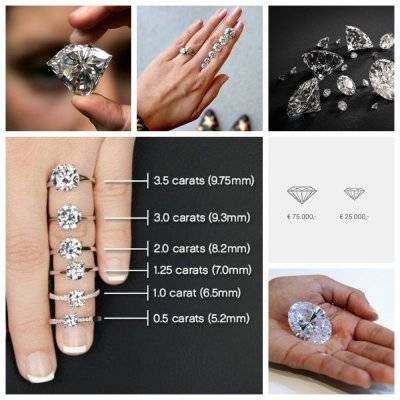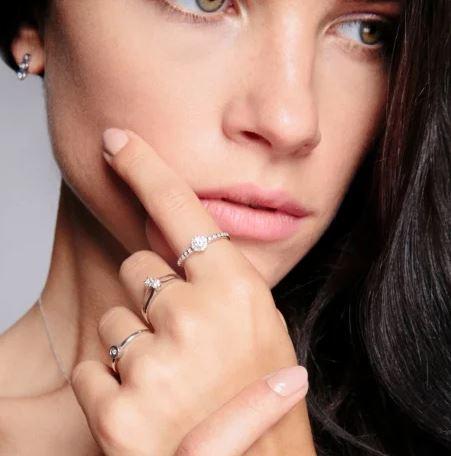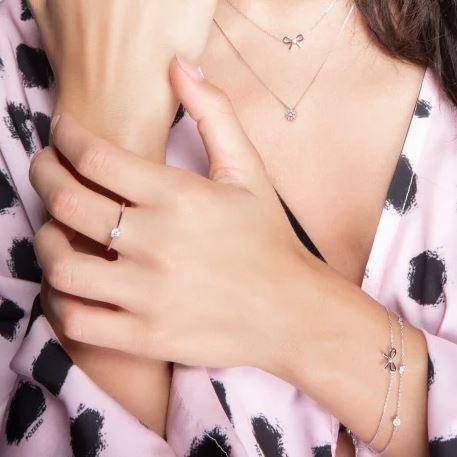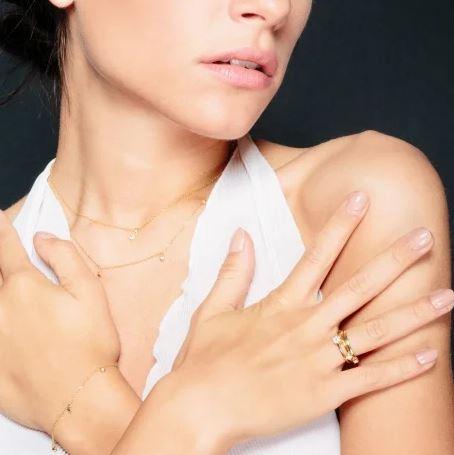
Diamond and diamond - feel the difference!
Contents:
- What does a diamond look like? What is this stone?
- What is a diamond?
- Diamond and brilliant - how does a rough stone turn into a gem?
- Diamond and diamond - differences
- Brilliant and brilliant - the correct nomenclature
- Diamond and diamond - which is more expensive?
- Diamonds and polished diamonds - what affects the cost of cut stones?
- Diamond or diamond? You already know the answer!
A woman's best friends - this is how the legendary Marilyn Monroe sang about diamonds. There is a reason why this gemstone is most often chosen on the occasion of an engagement. A faceted diamond in a ring is one of the most classic, elegant and luxurious jewelry solutions. A diamond often appears next to a diamond, and the use of both of these terms in the offers of jewelry stores causes a real stir. Engagement ring with diamond or diamond? This is the most common question for future brides. We explain the difference between diamond and diamond. We are sure that the answer will surprise many of you.

What does a diamond look like? What is this stone?
Diamond is the hardest and most valuable gemstone found in nature in the world. The process of its formation occurs in the earth's structure under conditions of high temperature and high pressure. A rough diamond has an irregular shape, matte color and medium brilliance, so in the "raw" version it is not particularly impressive. Only after proper processing does it acquire a beautiful appearance and unique radiance - and it is in this form that it is used in jewelry.
What is a diamond?
Brilliant is the official name for a round diamond with a full brilliant cut. Simply put, we can say that a diamond is a cut diamond. In colloquial language, diamonds are usually used to describe all diamonds, not just brilliant-cut diamonds, which is obviously a mistake. Their exact names should be used to describe other cuts. A brilliant cut contains at least 57 facets, round sulphur, at least 32 facets and leaf at the top, and 24 facets (sometimes also a flattened tip) at the bottom. It is found in approximately 70% of diamonds and is considered the greatest achievement of the masters of jewelry.
Diamond and brilliant - how does a rough stone turn into a gem?
Diamond jewelry is synonymous with luxury, timeless elegance and refined taste. However, the journey from diamond to brilliant begins with carbon crystals hidden in the deep layers of the earth. The crystallization process of diamond takes millions of years, but it produces the hardest and very rare mineral in the world. As a result of tectonic processes, the diamond is slowly moving towards the earth's surface, from where it is mined by man. At this stage, the raw stone has nothing to do with the dazzling gemstone we know from jewelry. It has the form of crystals with not very smooth and rounded edges. Only thanks to the painstaking work of cutters and artists, it acquires a unique shape and brilliance, and therefore is suitable for creating precious jewelry.

Diamond and diamond - differences
The difference between a diamond and a diamond is noticeable to the naked eye. The former is rather unremarkable, while the latter impresses with its impeccable brilliance and a jewel that exudes luxury. Check out what is the difference between diamond and diamond.
diamond vs diamond
| diamond | Diamond |
| It happens naturally in nature | It was created by polishing a diamond |
| It is taken out of the ground | It's a grinder's job |
| Has a matte finish and medium sheen | Fascinates with its brilliance and crystalline structure |
| It comes in yellow, blue, black, brown and colorless colors. | It has a colorless to yellowish tint. |
Brilliant and brilliant - the correct nomenclature
A diamond and a diamond are not two different stones and are not synonymous. When we say "diamond" we mean the raw stone that is mined from the ground and turned into a diamond in the hands of a cutter. Here it must be said that every diamond was once a diamond, but not every diamond can be called a diamond - only one that has a brilliant cut.
In jewelry stores, you can usually find both of these forms in product names, which should be convenient for buyers who use these terms interchangeably. In fact, this introduces unnecessary confusion and a number of questions like: “Diamond or diamond?”, “What is more expensive - diamond or diamond?”, “Diamond or diamond - which is better?”, “Engagement ring with diamond or diamond?”.
If the product name says “diamond ring”, it is always a round cut diamond. If the name of the item is “diamond ring”, then it is always a diamond cut, in most cases a brilliant cut, because this cut is the most popular on the market, but not necessarily because other cuts are available, such as cast, princess or pear.
So questions like: “Diamonds or diamonds”, “Diamond or diamond for engagement?”, “Diamonds or diamonds - which is more expensive?”, posed in the context of the desired jewelry, are a common misunderstanding, because there is no diamond. in jewelry offered on the market, uncleaned. For example, when we talk about the stones that adorn our rings, we can use the term "brilliant" but always mention the type of cut. The name "brilliant" is reserved only for a round cut diamond that meets certain standards as outlined above.

Diamond and diamond - which is more expensive?
If we mean a raw, unpolished stone, and this, in fact, is a diamond, then it is clearly cheaper than a diamond, i.e. the same stone, which is given the corresponding cut. However, the question of which is more expensive - a diamond or a diamond, most often refers to jewelry offered on the market, and arises simply because of inaccurate nomenclature. Gentlemen who choose engagement rings for their partners very often think that diamond models are something completely different from diamond models, when in most cases they are talking about the same thing, because brilliant cut is the one that most often found in rings.
Thus, the question should not be “Diamond or polished – which is more expensive?”, but “What affects the cost of cut stones and why do they differ in price?”.
Diamonds and polished diamonds - what affects the cost of cut stones?
The four factors in Rule 4C affect the value of finished diamonds, including brilliant-cut diamonds:
- mass (carat) is a unit of carat mass (approximately 0,2 grams). The larger the mass of the stone, the greater its value. Interestingly, the price of one larger diamond will be higher than two smaller ones of the same weight. This is because larger diamonds are less common in nature;
- purity (clarity) - each diamond has a specific structure that has a significant impact on the characteristics of the stone. The fewer inclusions and spots, the more transparent and expensive the stone;
- color (color) - the most expensive stones are completely colorless and transparent, although it must be emphasized that they are very rare. To determine the color, a scale is used, indicated by letters from D (a completely colorless stone) to Z (a stone with the most yellow color);
- cut (cut) is a factor that stems not from the natural properties of the diamond, but from the work of the cutter, who gives the stone its final shape. A diamond (i.e. a round brilliant cut diamond) or a fancy shape diamond such as pear, marquise, oval or heart can be created in this way.
Diamond or diamond? You already know the answer!
You already know that a diamond is a cut diamond. Thus, every diamond ring is a diamond. Most of the diamond rings available on the market are diamond rings, i.e. the same stones that have just undergone the appropriate processing. Therefore, instead of continuing to wonder: “Diamond or diamond?”, Instead, think about what cut your chosen one might like. Classic and timeless diamond? Retro style emerald cut? Or maybe a "pear", resembling a drop of water?
Check out which wedding rings are trendy. Choose the model that will immediately appeal to your chosen one.
We wish you phenomenal jewelry for every day.
Leave a Reply